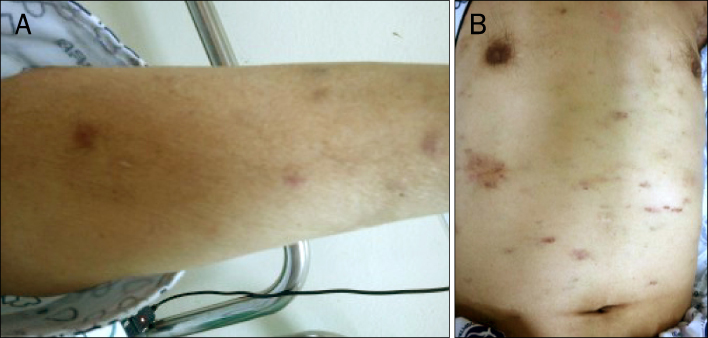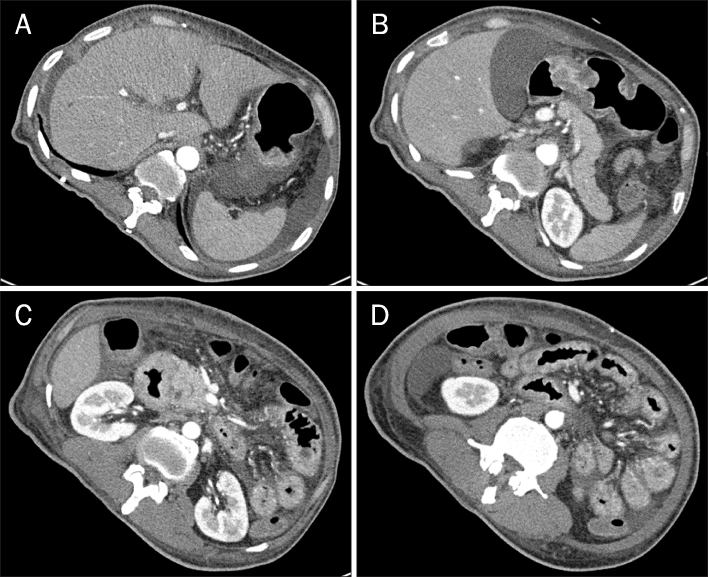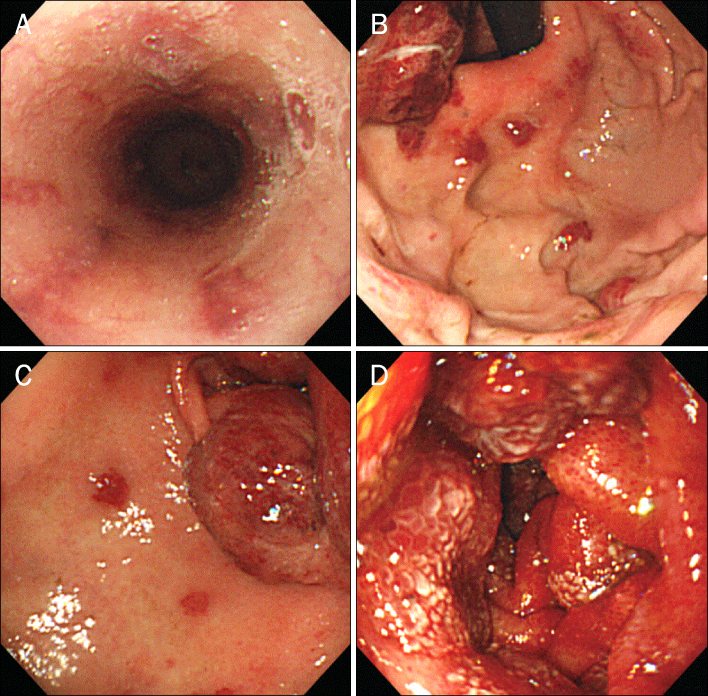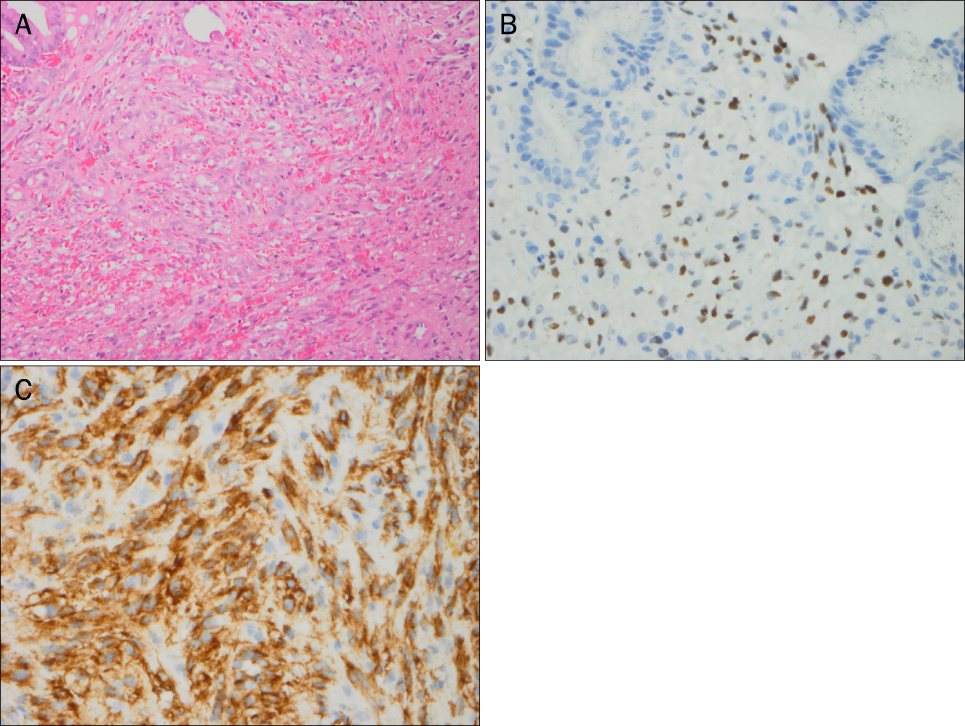Korean J Gastroenterol.
2012 Sep;60(3):166-171. 10.4166/kjg.2012.60.3.166.
AIDS-related Gastrointestinal Kaposi Sarcoma in Korea: A Case Report and Review of the Literature
- Affiliations
-
- 1Department of Internal Medicine, Chonnam National University Medical School, Gwangju, Korea. yejoo@chonnam.ac.kr
- KMID: 1389725
- DOI: http://doi.org/10.4166/kjg.2012.60.3.166
Abstract
- Kaposi sarcoma (KS) is a vascular neoplasm, which is fairly prevalent in acquired immunodeficiency syndrome (AIDS) patients. Mucocutaneous and lymph node involvements are characteristic features of KS in AIDS patients. The involvement of gastrointestinal tract occurs in 40% of KS patients and leads to significant morbidity and mortality. In the highly active antiretroviral therapy (HAART) era, the rate of AIDS related KS has fallen with control of human immunodeficiency virus (HIV) viremia. However, it is still recognized as the primary AIDS-defining illness, and the proportion of AIDS diagnoses made due to KS ranged from 4.1% to 7.5%. In Korea, AIDS-related KS has been report in low rate incidence. Its gastrointestinal involvements are rarely reported. To date, five cases have been recorded in Korea. Herein, we present an additional case of gastrointestinal KS as the AIDS-defining illness and review of the Korean medical literature.
MeSH Terms
Figure
Reference
-
1. Giraldo G, Beth E, Buonaguro FM. Kaposi's sarcoma: a natural model of interrelationships between viruses, immunologic responses, genetics, and oncogenesis. Antibiot Chemother. 1983. 32:1–11.2. Arora M, Goldberg EM. Kaposi sarcoma involving the gastrointestinal tract. Gastroenterol Hepatol (N Y). 2010. 6:459–462.3. Jones JL, Hanson DL, Dworkin MS, Jaffe HW. Incidence and trends in Kaposi's sarcoma in the era of effective antiretroviral therapy. J Acquir Immune Defic Syndr. 2000. 24:270–274.4. Kim JM, Cho GJ, Hong SK, et al. Epidemiologic and clinical features of HIV infection/AIDS in Koreans. Korean J Med. 2001. 61:355–364.5. Kim HS, Park HW, Jeon SH, et al. Gastrointestinal Kaposi's sarcoma in an AIDS patient. Korean J Gastrointest Endosc. 2000. 20:a420.6. Kim SH, Goo JM, Lee JW, Chung MJ, Lee YJ, Im JG. Pulmonary involvement of Kaposi sarcoma in an AIDS patient: radiologic and pathologic findings. J Korean Radiol Soc. 2002. 46:37–40.7. Moon HS, Park KO, Lee YS, et al. A case of Kaposi's sarcoma of the stomach and duodenum in an AIDS patient. Korean J Gastrointest Endosc. 2003. 27:148–152.8. Hong KD, Nam SW, Lee SE, et al. A case of Kaposi sarcoma of the bronchi and gastrointestinal tract in an AIDS patient. J Korean Geriatr Soc. 2007. 11:157–161.9. Chung DW, Chang HH, Hwang HY, et al. A case of gastrointestinal Kaposi sarcoma in a patient with AIDS. Korean J Med. 2009. 77:371–375.10. Beral V, Peterman TA, Berkelman RL, Jaffe HW. Kaposi's sarcoma among persons with AIDS: a sexually transmitted infection? Lancet. 1990. 335:123–128.11. Danzig JB, Brandt LJ, Reinus JF, Klein RS. Gastrointestinal malignancy in patients with AIDS. Am J Gastroenterol. 1991. 86:715–718.12. Dezube BJ, Pantanowitz L, Aboulafia DM. Management of AIDS-related Kaposi sarcoma: advances in target discovery and treatment. AIDS Read. 2004. 14:236–238. 243–244. 251–253.13. Nasti G, Talamini R, Antinori A, et al. AIDS Clinical Trial Group Staging System in the Haart Era--the Italian Cooperative Group on AIDS and Tumors and the Italian Cohort of Patients Naive from Antiretrovirals. AIDS-related Kaposi's sarcoma: evaluation of potential new prognostic factors and assessment of the AIDS Clinical Trial Group Staging System in the Haart Era--the Italian Cooperative Group on AIDS and Tumors and the Italian Cohort of Patients Naive From Antiretrovirals. J Clin Oncol. 2003. 21:2876–2882.14. Portsmouth S, Stebbing J, Gill J, et al. A comparison of regimens based on non-nucleoside reverse transcriptase inhibitors or protease inhibitors in preventing Kaposi's sarcoma. AIDS. 2003. 17:F17–F22.15. Bower M, Fox P, Fife K, Gill J, Nelson M, Gazzard B. Highly active anti-retroviral therapy (HAART) prolongs time to treatment failure in Kaposi's sarcoma. AIDS. 1999. 13:2105–2111.16. Lodi S, Guiguet M, Costagliola D, Fisher M, de Luca A, Porter K. CASCADE Collaboration. Kaposi sarcoma incidence and survival among HIV-infected homosexual men after HIV seroconversion. J Natl Cancer Inst. 2010. 102:784–792.
- Full Text Links
- Actions
-
Cited
- CITED
-
- Close
- Share
- Similar articles
-
- A Case of Kaposi's Sarcoma of the Stomach
- A case of gastrointestinal Kaposi sarcoma in a patient with AIDS
- A Case of AIDS-related Kaposi's Sarcoma
- Pulmonary Involvement of Kaposi Sarcoma in an AIDS Patient: Radiologic and Pathologic Findings
- A Case of Kaposi's Sarcoma of the Stomach and Duodenum in an AIDS Patient





